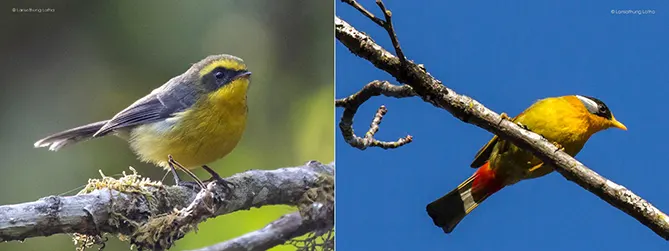[ Joel Rodrigues ]
“Birding is one of the best things that help us to connect with nature,” according to Leyamong from EcoWarriors. While he indulges in the activity throughout the year, he was at the Fakim Wildlife Sanctuary during the Tokhü Emong Bird Count (TEBC) in 2023. Fakim is a protected area close to the Indo-Myanmar border. Established in 1983, it covers 642 hectares, and boasts of a rich biodiversity. Leyamong added, “Last time, I went for birding with my friends. They were overwhelmed to see the birds at a close-range using binoculars. Their aura, colours and features magnified! My friends felt relaxed keeping their eyes and ears opened to spot the birds, and dwell on them.” Last year, among the species spotted at Fakim, was the Blyth’s Tragopan, the State Bird. Today, Nagaland has about 50% of the world’s dwindling population of the bird which has been classified as “vulnerable” on the IUCN Red List of Threatened Species.
Like the Tragopan, the Amur Falcons also hold a special place for the Nagas. T. Longshak Phom, Forest Guard at Longleng, plans to take students for birding next week as the migratory bird has arrived in Nagaland. Last year, he took students from Good Shepherd School to the forests of Alayong village. They later asked him to take them once again. During TEBC 2023, eight observers, including Longshak, noted almost 40 species in the district. A spectacle of 1000s of Amur Falcons was amongst them. The famous bird has been seen in different parts of the state from October to December.
Nagaland has a rich diversity of migratory as well as resident species. Kiphire district noted the near-threatened Ashy-headed Green-Pigeon for the first time in 2023 on the eBird App, where more than 100 million bird sightings are contributed every year. In 2024, Kiphire district has the most number of checklists, a list of every species identified to one’s ability by sight and/or sound and reported, on the app and recorded over 150 species. Binite, along with his students from Kiphire’s Loyola Higher Secondary School, joined TEBC 2023 and plans to repeat this year. He said, “These are delightful experiences for everyone. The students are always enthusiastic and curious about local species, their behaviour and environment. It helps foster deeper appreciation for our wildlife.”
While Kiphire district leads in the number of checklists, Kohima district leads the number of species recorded this year on the eBird platform with over 200. Amongst these were, the near-threatened Yellow-rumped Honeyguide. They are almost always seen in close proximity to the nests of Giant Asian Honeybee from whom the bird takes beeswax. They have also been observed to make use of the attacks of Asian giant hornet on the bees. Keviseno Rote took class 9 and 10 students from the Government High School Zhadima for TEBC 2023. They walked 3.5 km spotting diverse bird species. Rote said, “We need to encourage more student-led initiatives and presentations and involve local communities to reignite our deep cultural appreciation for nature.”
With the collaboration of the Directorate of School Education and EcoWarriors Nagaland, 20 schools participated last year. This year, more are planning to join. For Zukhathong from Pungro it was “a pilot experiment.” He added, “This kind of events not only imparts knowledge but also builds a bridge between the human and avian kingdom with the mother earth.” Khrievotsolie Henry, Assistant Professor from St. Xavier College Jalukie, later reflected, “The thrill of venturing into the nature, observing the different species of birds in their habitat, taking notes, and knowing the birds has to be the best experience. I have realised the immense worth of the free birds and their significance in the ecosystem.” With the ease of the eBird app, and mentoring of the EcoWarriors Nagaland team, more colleges can easily join TEBC by contacting them through their email address (ecowarriors021@gmail.com) or Instagram handle (@eco_warriors_nagaland). This year, the organisation won the ‘Radiant Wellness Award in the Field of Environment.’ The Nagaland Bird Monitoring Network’s Instagram page (@nagalandbirds) can also be used to receive updates on TEBC and yearlong birding activities.
TEBC is not only a time to revisit our backyards and forests to see, listen, and be mesmerised by birds. It is also a time to reconnect with our myths and legends centred on human-animal-plants relationship. Our ancestors grew and lived in a more harmonious world where animals and plants had names in local tongues with deeper meanings symbolising their place and relationship. Chenibemo Odyou from Foundation for Ecological Security recounted, “My grandfather, Yilao Odyuo, would often visit us from Lotsu village in Wokha district. He would tell us stories about the forests around our village and how the birds signalled the changing seasons-how their songs foretold the rains and the time to sow seeds. It felt as if the birds spoke a language our ancestors understood.” If not spotting birds in our gardens, fields and forests, TEBC can be a time to once again gather around the fire and listen to these stories. For elders, to recount them and the world they grew up. For the younger ones, to listen and envision a world recreated in fellowship, forgiveness and oneness… just as our harvest festivals are meant to be. (Rodrigues is a PhD Scholar, Department of Social Anthropology, Stockholm University)



